Improve Fishing in Your Pond
- Jump To:
- Know Your Fish
- Largemouth Bass
- Sunfish
- Bluegill
- Redear Sunfish
- Green Sunfish
- Hybrid Bluegill
- Channel Catfish
- Bullhead
- Crappie
- Fathead Minnow
- Common Carp
- Grass Carp
- Assessing Your Situation
- Corrective Actions
- Four Common Pond Fish Population Situations
- Management to Promote and Maintain Good Fishing
- Costs and Benefits
- Further Advice
- Further Information
- Acknowledgements
Most Oklahoma farm ponds are capable of producing better fishing if the pond owner is willing to invest some time, money, and effort. Your pond may already offer fair fishing and you may wish to improve what you have, instead of eliminating all fish and starting over from scratch. This fact sheet provides the information needed to make good choices in this situation. It will guide you in collecting information that will be useful, should you choose to visit with a fisheries biologist to develop a management plan.
Know Your Fish
To manage for good fishing, you must know the fish species you have in your pond. It is also good to be able to understand something about their diet and other habits, as well as recognize their “condition.” By looking at the side and top view of a fish, you can recognize whether it is well fed, average, or skinny.
Largemouth Bass
This much desired sport fish puts up a good fight. To tell it apart from other bass, look for a jaw that extends behind the eye. Young, very small largemouth bass will typically have a strong black stripe along the side. Young largemouth bass feed on insects but switch to fish at between two and three inches. They are visual predators and grow best in relatively clear water where they can easily see their prey.
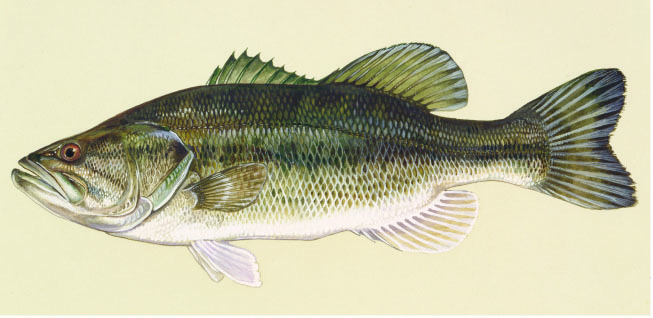
(Image credit: U.S. Fish and Wildlife Service)
Sunfish
These deep bodied panfish are often incorrectly called “perch.” The most common species are the bluegill, redear sunfish, and green sunfish.
Bluegill
A totally dark blue or black gill cover flap helps make this desirable pond fish recognizable. Also, look for a dark spot at the back of the dorsal fin (top fin) and for a very long pectoral fin (side fin) which extends ahead of the eye when folded forward. Young bluegill display strong vertical bars and have a bluish sheen. The diet is primarily insects or zooplankton, also known as water fleas. Foraging tends to be towards the top of the water column. In many ponds, bluegill are the main food of largemouth bass and a very good catch. Reproduction starts when they reach about 3 inches. Typical hook and line caught bluegill weigh 1/4 to 1/2 pound, but bluegill up to 4 pounds have been caught.

(Image credit: U.S. Fish and Wildlife Service)
Redear Sunfish
To recognize this desirable pond fish, look for a very long pectoral fin (side fin) which extends ahead of the eye when folded forward, a red or orange edge to the gill cover flap, and no spot on the back of the dorsal fin. These provide good eating and may help in controlling the yellow grub fish parasite. Diet includes insects, snails, mussels, zooplankton and fish. Primarily feeds around the pond bottom or mid-water column, if weed beds are present.
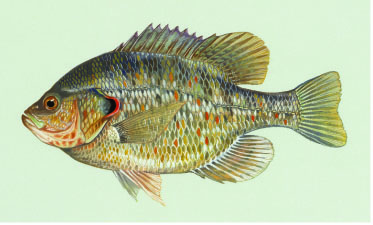
(Image credit: U.S. Fish and Wildlife Service)
Green Sunfish
A large mouth and blue-green “worm tracks” on the chee
ks and yellow or orange fringe on the fins help identify this undesirable pond fish. In very young green sunfish, the vertical bars are missing, and there is a greenish sheen and the dark spot at the back of the dorsal fin will be faintly present or missing. Excessive reproduction and stunting is a problem with green sunfish.
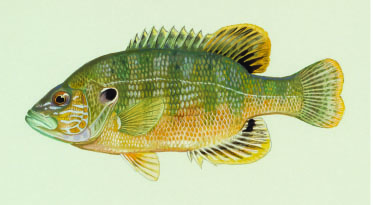
(Image credit: U.S. Fish and Wildlife Service)
Hybrid Bluegill
This desirable pond fish is a cross between bluegill and green sunfish. They can grow quickly on a pelleted diet, and eagerly take bait, making them a great supplemental sport fish. But they reproduce poorly and so require restocking from time to time. This trait makes them a poor forage fish for bass.
Channel Catfish
This desirable pond fish should be managed by periodic restocking to replace those removed from the pond. Ten inch or larger channel catfish are recommended for stocking in ponds where large bass are present. Do not put out tires or other spawning containers to encourage catfish reproduction, as the number of young are typically too large for the pond to support. Maximum size is around 55 pounds, but typical hook and line caught catfish are 1 to 5 pounds. The forked tail and curved anal fin (bottom fin) distinguishes it from similar species.
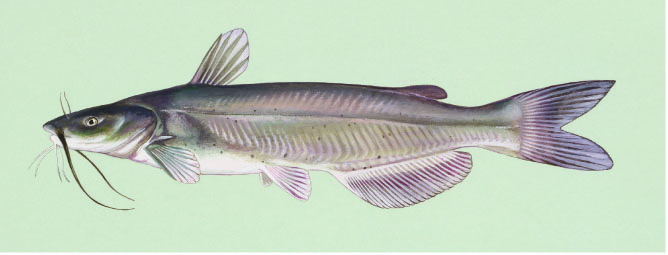
(Image credit: U.S. Fish and Wildlife Service)
Bullhead
This undesirable fish reproduces excessively and only grows to a small size. It is often seen swimming in groups or schools. The tail is not forked.
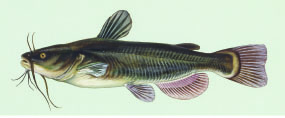
(Image credit: U.S. Fish and Wildlife Service)
Crappie
Because of their ability to produce very large numbers of young in certain years, crappie are undesirable for most farm pond situations. They compete for food with both bluegill and largemouth bass. The diet changes from insects to fish when crappie are about 7 inches. When a year of excessive reproduction occurs, there are more crappie young than the bass can control. This leads to a large population of undesirably small, thin crappie.
If you wish to try crappie in your farm pond, know that the larger the pond, the better your chance of success. Minimum recommended pond size generally ranges from 10 to 100 acres. Be aware that the quality of largemouth bass and bluegill fishing will decline when crappie are present. Crappie should only be stocked if you know all the above facts and have the time and management skill to monitor and regulate the fish catch to maintain an abundance of largemouth bass and a good amount of forage fish, like bluegill.
Black crappie are preferred in ponds because of a somewhat lower amount of reproduction, but even then the pond must have an abundant bass population to control reproduction. Black crappie prefer relatively clear water. White and black crappie can be told apart by the number of spines in their dorsal fin (top fin). White crappie have five or six dorsal fin spines, while black crappie have seven or eight. Count by feeling the spine tips with your finger.
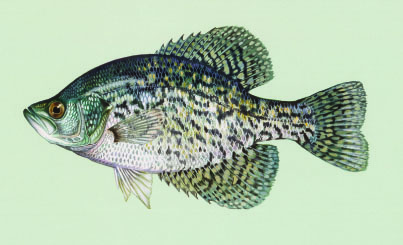
(Image credit: U.S. Fish and Wildlife Service)
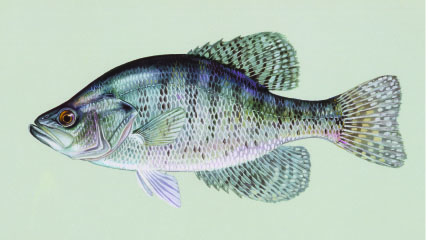
(Image credit: U.S. Fish and Wildlife Service)
Fathead Minnow
This common baitfish is sometimes used as additional forage for largemouth bass, but typically they are quickly eliminated and have little benefit. It lays its eggs on the underside of the leaves of aquatic plants. If aquatic plants are absent, sheets of old plywood or something similar should be provided.

(Image credit: U.S. Fish and Wildlife Service)
Common Carp
This generally undesirable fish can swim up and over auxiliary spillways or wash in from upstream ponds. In high numbers, it will muddy a pond as it aggressively bottom feeds and stirs up sediment.
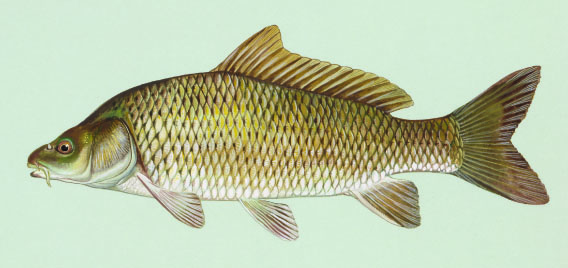
(Image credit: U.S. Fish and Wildlife Service)
Grass Carp
This exotic fish is often stocked for control of aquatic plants. Do not confuse it with the common carp. The grass carp body is streamlined and cigar shaped. Beware of its potential to eliminate desirable submerged plant beds. They have a tendency to swim out of ponds when they overflow, so a fish barrier is recommended to retain stocked grass carp.
Assessing Your Situation
There are two ways to learn about the state of your fish population. First, keep good records of what you are catching by hook and line. For your convenience, a daily fishing log form is attached (Figure 1). Make photocopies so you can record information about what you catch. The fishing log has space to record species name, length, condition, total hours of fishing, and fish condition. Record the information for each fish you catch on a separate line. Fill out a card each time you fish your pond for at least several trips and you will begin to develop a good picture of the state of your pond fishery. The more completed fishing logs, the better the picture. Keep your cards and consider sharing them with a fisheries biologist as discussed elsewhere in this fact sheet.
Figure 1. This form allows anglers to record information about the quality of fishing in a pond. Makes copies of it and ask anglers to keep track of what they catch. Enter information for each fish caught on a separate line.
Daily Fishing Log
Pond Name____________________________________________ (different card for each pond)
- Month _________________________
Day ____________
Year_____________ - Number hours fishing times number of people= _________________
- Species Tot Length* Condition** Kept or Released?
__________ _____________ ___________ ______________
__________ _____________ ___________ ______________
__________ _____________ ___________ ______________
__________ _____________ ___________ ______________
__________ _____________ ___________ ______________
* Length from tip of closed mouth to end of fin lobes pressed together
**Condition key: Poor (skinny), Normal, Excellent (fat) (evaluate top view of head vs. body)
4. Other observations: ____________________________________
The second method of evaluating the state of your fishery is to use a minnow seine in shallow shoreline areas (Figure 2). As you look over the catch, remember that small fish have a different appearance than adult fish (Figures 3 and 4). Taking good digital photos of your catch will give you the option of sharing it with a fisheries biologist as discussed at the end of this fact sheet.
Some ponds have problems that need to be recognized and considered before investing time and money in improving your fish population.
- A pond smaller than 1/2 acre should not be expected to produce good largemouth bass fishing. A typical 1/2 acre triangular pond will have a dam that is about 300 feet long, and if you stand in the middle of the dam, it will be about 150 feet to the beginning of the neck of the pond. To ensure you have estimated the size of your pond correctly, make a sketch of the pond shape, step the dimensions and seek help from a pond professional.
- If a pond is deeper than average, there is a higher risk of fall fish kills due to pond turnover.
- Ponds that are surrounded by trees or that catch leaves can suffer from water quality problems that can lead to fish kills.
- A pond that is more than 50 percent covered by aquatic plants is likely to have low oxygen problems. Twenty percent coverage is considered ideal for fishing purposes.
- Excessively muddy ponds are not suited to bass and bluegill stocking. If the muddiness is not correctable (see NREM-9206), catfish or hybrid bluegill stocking and regular feeding with a pelleted fish food can still be successful.
- Ponds that have a dense greenish color may be too high in nutrients and subject to low oxygen fish kills. Check the ponds during the warm months on a sunny day to determine how deeply a submerged white object can be seen. If the object disappears at less than 18 inches then the pond may be receiving excessive amounts of nutrients from fertilizer runoff, animal manure runoff or septic systems.
- If there are other ponds upslope that have undesirable fish, these are likely to wash into your pond whenever ponds are overflowing.
- Beware if there are contaminant sources above the pond. These include areas where pesticides are applied, illegal dump sites and some oil field operations.
- Ponds that do not support fish of any type should be viewed with suspicion. Water in some areas in western Oklahoma may have too high of a hardness level for fish due to the presence of gypsum.
- Ponds with small watersheds may go dry during dry periods. Check with your Natural Resource Conservation Service office if you believe your pond has this problem.
- In addition to looking for possible problems with your pond, you need to determine the type of fishing you would like to produce. These are some commonly considered options:
- General good fishing – A combination of catchable-sized largemouth bass, bluegill, and channel catfish is a common goal. If you do not have a preference for type of fishing, the “general good fishing pond” can work well for you. You must control the numbers of bass that anglers remove.
- Kid’s fishing – Children want to catch something without a long wait. An excellent choice for a kid’s fishing pond is hybrid bluegill. Channel catfish can be stocked along with the hybrid bluegill if you wish. Record the numbers of fish caught so the pond can be properly restocked from time to time.
- Trophy bass – If nothing else will do except the thrill of hooking some very big bass, then you need to take some extra steps to achieve your goal. If you are willing to give up other types of quality fishing and manage your pond closely, then you can manage for trophy bass. Trophy bass management is discussed in the publication, “Managing Pond Fisheries in Oklahoma.” See the “Further Information” section for information on how to obtain a copy.
- Catfish for the table – Channel catfish are a hardy and easy to raise species that can be stocked along with bass and bluegill at low numbers or raised by themselves in greater numbers if pelleted fish food is fed. Never feed more than the fish can clean up in 15 minutes, and keep the total amount of feed below 20 pounds per acre per day. Keep records of the numbers removed and restock from time to time. Do not provide spawning containers for catfish.
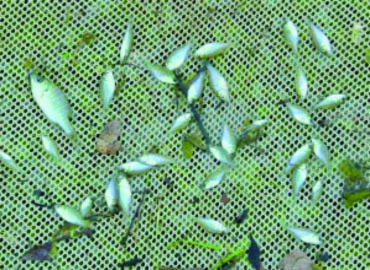
Figure 2. Minnow seine hauls will not capture larger fish but should capture fish from a few inches down to less than one inch. This provides excellent information about the state of your fishery. Remove the plants and wash away the mud. Good photos will allow for fish identification and show the numbers of fish of each size, insects, and other pond animals like tadpoles and crawfish. (Photo credit: Alabama Department of Conservation and Natural Resources)
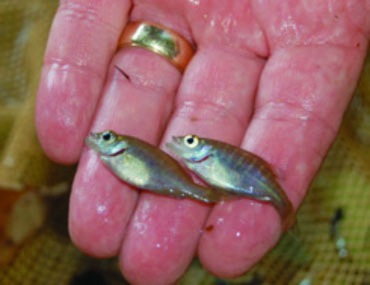
Figure 3. Young bluegill have vertical bars. (Photo credit: Outdoor Alabama)
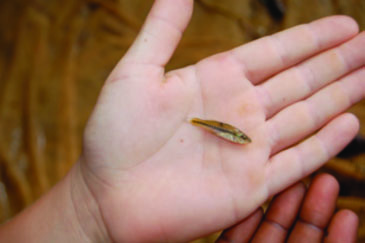
Figure 4. Young largemouth bass can be identified by their single, strong horizontal stripe. (Photo credit: Outdoor Alabama)
Corrective Actions
There are several options for managing a fishing pond that has problems with fish populations. Some of these options can be expensive. Others simply require patience.
Renovation – Eliminating all the fish in a pond is known as pond renovation. A low cost, but time- consuming way to do this is to drain the pond and let the bottom dry completely. Ponds that do not have drains can be emptied by using a pump set or siphon. An alternative to draining is the use of rotenone, a fish poison. This poison gradually breaks down, allowing the pond to be restocked. Rotenone is costly, and is a restricted use pesticide, only available to certified applicators.
Restocking – The stocking of small fingerlings is only recommended in new ponds or those that have been renovated. Small fish are quickly eaten by largemouth bass or other predators; therefore they should only be stocked in waters without predators. More information on obtaining fingerlings from private hatcheries or through the free, state stocking program can be found in CR-9205, “Fingerlings for Pond Stocking.” The standard stocking recommendation for a “general good fishing pond” is 500 bluegill fingerlings and 100 channel catfish fingerlings per surface acre in the fall, followed by 100 largemouth bass fingerlings per acre in the spring.
Transplanting large fish – In some cases, adding adult largemouth bass can help reduce the numbers of over abundant bluegill. If you choose to transfer fish from other waters, do not forget to obey legal daily catch limits. In addition, most large public waters are better avoided because of the chance of introducing largemouth bass virus, watermilfoil, golden algae, zebra mussels or other problems to your pond.
Increasing or decreasing harvest – Sometimes it is advisable for a pond owner to change the number of fish being removed. For instance, in a pond with a large number of stunted bass, a pond owner might try aggressively fishing to reduce their numbers.
Late spring drawdowns – One method to reduce excessive sunfish numbers is to substantially lower the water level for several months to concentrate predators and prey. This allows predators to consume many of the over abundant sunfish.
Four Common Pond Fish Population Situations
As you keep reading, you will be rewarded with a better understanding of how good fishing pond management works. The recommendations may strike you as complicated. This is because bass-bluegill pond management is much like aiming at a set of moving targets. These targets not only move, but also grow and shrink in size from year to year, making simple harvest recommendations difficult. Perhaps this elusive quality is consistent with the sport of angling.
After gathering information on your pond fishery by hook and line catch records and perhaps minnow seine catch, you are ready to consider management options. Begin by seeing if your pond fits one of these four common scenarios:
Case 1. Overabundant, skinny bass. Many with a total body length of 11 to 12 inches.
Recommendation: Remove up to 25 pounds of skinny bass per acre. Remove the most abundant size bass and return bass of other sizes that are in good condition. Check the condition of the bass you catch by hook and line after a few months. If they remain skinny, remove another 25 pounds of skinny bass per acre. Repeat as needed.
Case 2. Overabundant, skinny bluegill that are 3 to 5 inches in length with a few large bass.
Recommendation: Stock additional large adult bass and return all bass caught to the pond. Do not restock with bass from public waters to avoid introducing largemouth bass virus or serious nuisance species. Do not exceed the legal catch limit if you transfer bass from public waters. Be careful to follow the harvest guidelines, shown in figure 5, and do not remove bass until the situation improves.
Case 3. Undesirable fish species like green sunfish, common carp, bullheads and goldfish are abundant. Bass are few in number. Bluegill are small and skinny.
Recommendation: Renovate the pond (eliminate all fish) and restock. Prevent undesirable fish from getting into the pond. Undesirable fish species can wash in from higher ponds, be stocked intentionally by poorly informed anglers, be introduced by the dumping of bait buckets into the pond, or swim upstream across earthen spillways during overflow events.
Case 4. Bass and bluegill of all sizes present in good condition.
Recommendation: Maintain proper bass harvest. If starting with a new or renovated pond, good balance can be achieved by following these guidelines: Do not remove any bass for three years after stocking. Beginning in year four, remove 25 to 50 bass (less than 12 inches) per acre each year. However, if they are very abundant, more may be removed, if they are very scarce, then none should be removed. Do not remove any bass that are 12 to 18 inches in length, unless they become skinny – then follow the guidelines in Case 1. Remove over 18 inch bass according to your objectives – to produce larger size bass harvest more heavily. To maintain a greater number of large bass, harvest over 18 inch bass lightly.
Management to Promote and Maintain Good Fishing
Time and effort must be put into managing a bass-bluegill pond if good fishing is to be achieved. Rules for anglers must be explained to them and enforced. The main tasks of the pond manager are to:
- Educate all anglers as to what species and sizes of fish are acceptable to keep and what must be returned to the pond (Figure 5).
- Keep track of the size, abundance and condition of fish of each species. Good fishing records are the best way to do this (Figure 1).
- Ensure that live bait buckets are never emptied into the pond and other fish are never added without your advance knowledge and approval.
- Keep an eye on aquatic plant growth and the clarity of the water, as described elsewhere in this Fact Sheet.
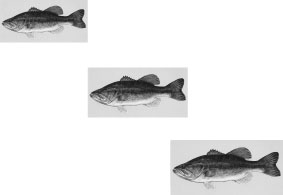
12 inches and under 50 bass per year per acre (starting in year 4)
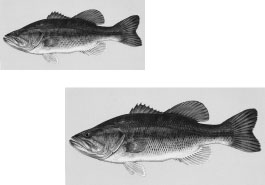
12 to 18 inches bass Return all to pond
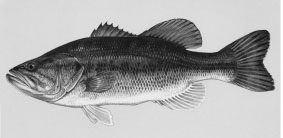
18 inches and larger Harvest according to pond owner objectives
Figure 5. Proper bass harvest is critical to the success of your bass-bluegill fishing pond. To manage for good general fishing, return all bass to the pond for the first three years following stocking of a new or renovated pond. Beginning in year four, remove the numbers of bass shown above. Remove bluegill by hook and line as you wish. See Case 4 for more detailed harvest recommendations.
Selective harvest (Figure 5) is essential for good bass-bluegill fishing. The goal is to maintain a balance of small, medium and large sizes of bass and bluegill. When all sizes of bass and bluegill are present, bass have enough to eat. This balanced bass population keeps the bluegill population cropped down so they too have enough food.
Bass and bluegill swallow their food whole. If a food item is too big, they cannot eat it. If it is small, it takes too much work to capture. Because of this, a good fishing pond needs a balanced mixture of small, medium and large bass and bluegill. One way to picture this balanced mixture of sizes is to imagine that a fishing pond is a series of buffet lines. For the sake of simplicity, let us say there are three buffet lines—one for small bass, one for medium size bass, and one for larger bass. As a young bass moves down one line, it grows and must switch to the next buffet line where the food items are larger. Bluegill eat insects and other small pond life. As they grow, they also must switch to the next buffet line when they need larger food items.
A well run set of buffet lines (Case 4) will have enough food. To ensure there will be enough food of the right size for both bass and bluegill, the pond owner must harvest the right number and size of bass. The 12-inch and under bass must not be allowed to become too numerous, or they will eat too many small bluegill, leaving nothing for the next generation of bass. The 12- to 18-inch bass must all be returned to the pond, to ensure there will be replacements for the 18-inch or larger bass. The pond owner has some flexibility in choosing how to harvest the 18-inch and larger bass. He can harvest them lightly and have a fairly large number of big bass or more heavily to try reducing competition for food and produce trophy bass. Returning every small, medium and large bass to the pond is a mistake made by many pond owners. This “catch and release” of all sizes causes the bass to run low on bluegill and become skinny. (Case 1.)
Consider the pond where too many bass are caught and removed. Without enough bass, too many bluegill survive. They are underfed but not so starved that they fail to reproduce. Soon there are far too many bluegill, and they are eager for anything to eat. The bass are mobbed on their nests and they are unable to protect their eggs. As a result, there are too few young bass of the right size to eat small bluegill and pond fishing quality declines. (Case 2.)
Aquatic plants can cause serious problems if overabundant, but some submerged plant beds are highly desirable in bass-bluegill ponds. Submerged plant beds provide an important part of those “buffet lines.” Weed beds are places where bluegill can find insects and seek refuge from bass. Ponds that have about 20 percent coverage by aquatic plants are considered ideal for fishing. From 5 to 25 percent coverage is acceptable. Ponds that lack submerged plant beds may benefit from artificial structures, such as sunken eastern redcedar trees, but many trees will need to be added before an effect can be seen.
If too much of the pond is covered by plants with floating or emergent leaves, then pond oxygen levels can drop and cause a fish kill. Sunlight must penetrate the water so submerged plants and microscopic algae can produce oxygen.
There is no easy, permanent cure-all for ponds with excessive plant growth. Begin by seeing if it is practical to deepen shallow areas, to discourage rooted aquatic plants, or reduce sources of excess nutrients. Herbicides offer fast, but short-term control. They also pose the risk of a fish kill if too much plant material is killed at one time, which decays and uses oxygen in the pond. Visit with your county’s Extension agriculture educator, ODWC fisheries biologist or other pond professional. Additional reading is suggested at the end of this Fact Sheet. Grass carp frequently eliminate submerged plant beds and must be used with caution in ponds where fishing is important.
Excess fertility may be a problem in your pond if you notice a heavy greenish color to the water. It is normal for Oklahoma waters to have a green tint, but when submerged objects can no longer be seen at less than 12 inches on a clear, sunny day, a pond is considered to be too fertile. The green tint comes from microscopic plants known as phytoplankton. If too much phosphorous enters a pond, the number of phytoplankton increases. These heavy blooms of phytoplankton can die, causing oxygen levels to drop to zero. Controlling the sources of excess nutrients is critical to long-term improvements in water quality. Livestock, agricultural runoff, leaking septic systems, or lawn fertilizers may all contribute to the problem. Eliminating, reducing, or re-routing these sources should be your goal.
Muddiness is not only ugly, but also blocks sunlight from entering the pond. Without sunlight penetration, a pond will have little plant growth and production of the food items needed for bass and bluegill. Without sunlight the “buffet table” shrinks and much less food is available. See NREM-9206 for information on correcting excessive muddiness. In cases where muddiness cannot be corrected, stocking of channel catfish and/or hybrid bluegill, in combination with a feeding program, can be considered. Muddiness will not cause a muddy taste in fish.
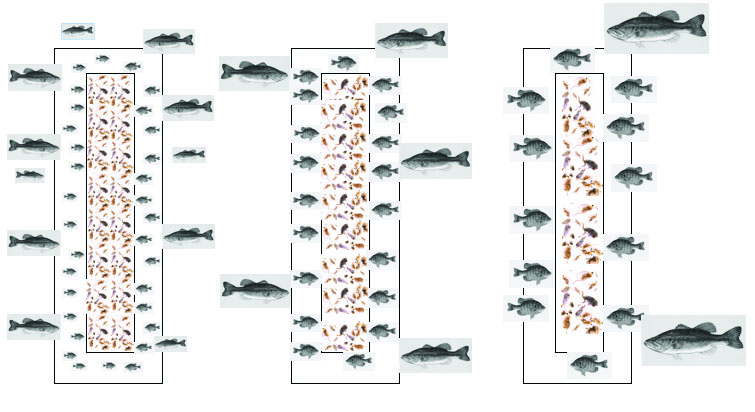
Figure 6. A well balanced fishing pond has bass and bluegill of small, medium and large sizes. This enables the bass to keep bluegill numbers cropped down which in turn benefits bluegill by ensuring they have enough to eat.
Costs and Benefits
Time, money and effort are required to produce and maintain good fishing. If the type of fishing you originally considered will require more than you are willing or able to provide, consider switching to another kind of fishing. Are there problems you will not be able to control, such as fishing access by too many people, an eroding watershed, contaminant sources, or ponds above you with undesirable fish? If there are such problems and they cannot be controlled, then you may need to consider a different kind of fishing for your pond or minimize the time and money spent on improving the pond fishery.
Further Advice
With more than 200,000 ponds in Oklahoma and a limited number of fisheries biologists, you will not always have the opportunity for someone to look at your pond firsthand. Instead you may need to gather information and share it with a biologist in person, via the internet, or phone. The quality of the advice you receive can be no better than the quality of information you provide, so make an effort to gather good information as outlined in this Fact Sheet. There are a number of places to seek expert advice on your particular situation. This includes the following offices of the Oklahoma Department of Wildlife Conservation:
Northwest Region Fisheries Office – Byron, 580 474-2663
North Central Region Fisheries Office – Ponca City, 580 762-2248
Northeast Region Fisheries Office – Jenks, 918 299-2334
East Central Region Fisheries Office – Porter, 918 683-1031
South Central and Southeast Region Fisheries Offices – Caddo, 580 924-4087
Southwest Region Fisheries Office – Lawton, 580 529-2795
Central Region Fisheries Office – Holdenville, 405 379-5408
Oklahoma City area Fisheries Office – Norman, 405 325-7288
Further Information
Managing Pond Fisheries in Oklahoma, a limited supply of print copies are available for $3.00 each from ODWC, PO Box 53465, Oklahoma City, OK 73152. Before ordering, check for availability at wildlifedepartment.com, Outdoor Store – Publications. Once the supply is exhausted, it will be posted online.
NREM-9206, Common Pond Problems
CR-9205, Fingerlings for Pond Stocking
SRAC -360 – Aquatic Plant Management: Control Methods
SRAC-361 – Aquatic Plant Management: Herbicides
Aquatic plant identification and management advice is also available at https://aquaplant.tamu.edu/plant-identification/
Acknowledgements
The author thanks Gene Gilliland for his substantial contribution to this Fact Sheet.
Marley Beem
Assistant Extension Specialist




